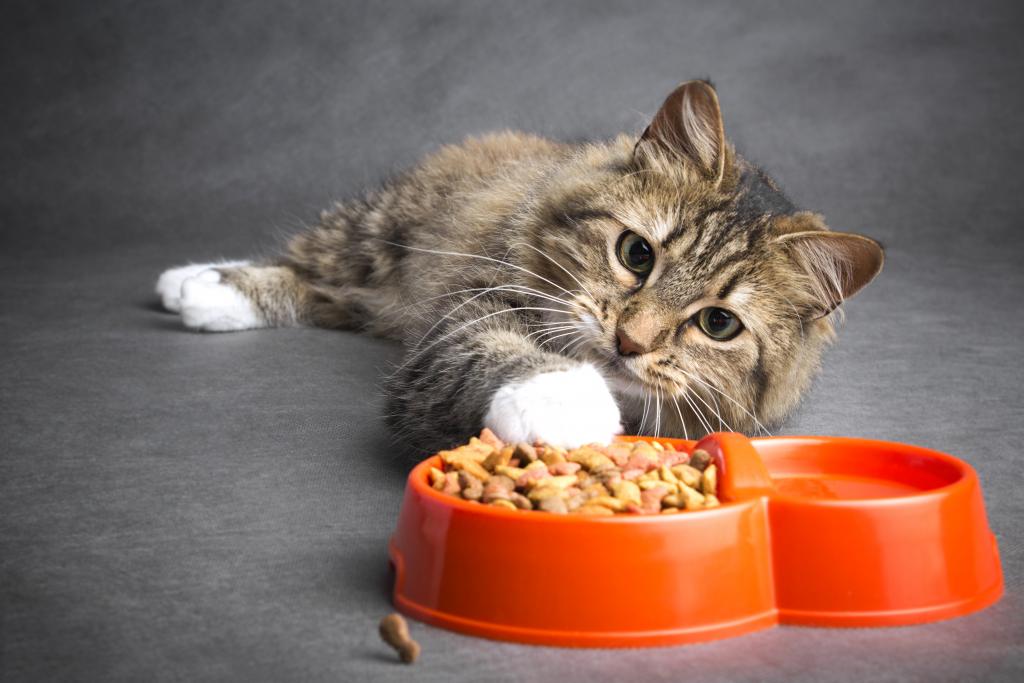Choosing to become a cat owner is a big decision. Once you welcome an adorable kitten or loving older cat into your home, you’re responsible for their care and well-being for many years to come. And while cats might seem pretty low maintenance as far as pets go, their care can come with steep costs. The price of food, routine veterinary care, and even toys or grooming accessories can add up fast.
Simply feeding your cat can total hundreds of dollars per year. According to CostHelper, dry cat food costs between $5 and $8 per four-pound bag, while canned wet food costs between $16 and $38 for a month’s supply¹. That can add up to over $450 in canned food alone in just one year. And this can make it difficult for low-income cat owners to properly care for their pets.
 fantom_rd / Shutterstock
fantom_rd / ShutterstockIf you’re having trouble affording your cat’s food, you aren’t alone. But you – and your cats – don’t need to struggle. Here are a few places you may be able to get low-cost, or possibly even free, cat food.
Animal Shelters
Animal shelters are where pets in need of homes reside. In order to keep the pets in their care safe, healthy, and well-fed, animal shelters often take in donations for all kinds of supplies. One of the most common donations is food – and your local animal shelter may have additional food.
Ask your local animal shelter if they have any extra food available for in-need pet owners. They may be able to offer you their excess food at a low cost or for free. Just keep in mind that the shelter may want to see proof of your low-income status before they give away any food.
Additionally, some animal shelters actually operate pet food banks². If your local animal shelter has a pet food bank, you may be able to apply for food subsistence³. Give them a call and ask about any food bank or free food programs for low-income pet owners.
Meals on Wheels
Meals on Wheels may be a nonprofit organization that’s dedicated to feeding senior humans. But the organization hasn’t forgotten about hungry pets. Because so many seniors live with pets, Meals on Wheels created We All Love Our Pets (WALOP), an initiative dedicated to providing food for the pets of older adults⁴.
The Meals on Wheels WALOP initiative is designed to offer free pet food to seniors who are struggling to provide food for their animals. People can donate food for WALOP, and that food is given out by regional chapters of Meals on Wheels when volunteers bring meals to local seniors⁵.
You can contact your local Meals on Wheels organization chapter to see if WALOP is available in your area. Keep in mind that there may be an age, income, or mobility requirement that you need to meet in order to begin receiving food.
The Humane Society
The Humane Society is dedicated to caring for animals across the United States, and the organization has chapters in many local communities. While many of the Humane Society’s work is focused on the care and treatment of animals, they also may be able to help low-income cat owners.
Visit the Humane Society’s website, and you’ll find a lengthy list of different national and local pet organizations – all of which offer benefits like free pet food, affordable spay and neuter services, and even temporary foster care⁶. You can search these organizations, determine which may be able to help you get free or low-cost cat food, and contact those organizations to receive help.
Local Pet Food Banks
Another good place to find low-cost or free cat food is right in your own neighborhood. You might know about food banks, which offer donated food for free to individuals in need. But what many people don’t realize is that many local communities also offer pet food banks.
Pet food banks operate just like human food banks: if you’re in need, you can come by and get a selection of food for free. At some pet food banks, you may even be able to get more than food. For example, the C.A.R.E. Pet Food Pantry offers cat food as well as bowls, toys, and other pet supplies⁷. The PAWS Chicago pet food bank offers both pet food and cat litter, collars, cat carriers, and more⁸.
Search online to find pet food banks in your local area. You can also check with local nonprofit organizations to see if they can help direct you to pet food banks so you can get both the cat food and supplies you need.
Cat Owners Can Shop for Low-Cost Cat Food Online
If you’re struggling to pay the high prices of cat food, there are ways to save. You don’t always have to pay full price, even at popular pet food retailers and websites. If you do your research, you can find lower prices, special deals and savings, and even discount events.
The key is to search online and compare prices from a few different pet food websites. Retailers offers all kinds of pet food online, and you’ll likely find your cat’s favorite food from a few different online shops. You should compare the products and their prices to see if one offers a better value.
Additionally, you should search for discounts, deals, and other ways to save. For example, you can save anywhere from five to 10 percent on every purchase if you buy your cat food through Chewy’s Autoship program⁹. Petco offers a discount of 35 percent on customers’ first repeat delivery purchase, and then access to the lowest pricing available on future orders10.
Savings like these are just a sample of what you might find. If you shop around online, search for available discounts, and compare offerings and prices, you can hopefully lower your cat food expenses and save money.